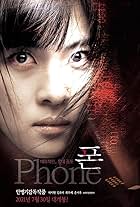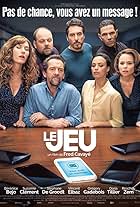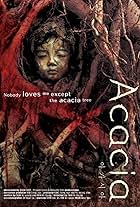IMDb RATING
5.8/10
2.6K
YOUR RATING
Jiney, an artist, witnesses a car crash. She photographs the victim, becoming obsessed with death. She receives a snuff video. Her friend Jas realizes it's real. Jiney gets another disturbin... Read allJiney, an artist, witnesses a car crash. She photographs the victim, becoming obsessed with death. She receives a snuff video. Her friend Jas realizes it's real. Jiney gets another disturbing tape, leaving her terrified.Jiney, an artist, witnesses a car crash. She photographs the victim, becoming obsessed with death. She receives a snuff video. Her friend Jas realizes it's real. Jiney gets another disturbing tape, leaving her terrified.
- Awards
- 6 nominations
- Director
- Writers
- All cast & crew
- Production, box office & more at IMDbPro
Storyline
Did you know
- Trivia(at around 8 mins) The car crash towards the beginning of the movie is the same one used in this film's companion, Ah ma yau nan (2004), which was directed and co-written by Danny Pang, Oxide Chun Pang's twin brother.
Featured review
As the previous reviews might suggest, Ab-normal Beauty (2004) is something of a difficult film to pin down; both in terms of its abstract visual style and the actual presentation of the plot. In terms of appearance, the film is a visual labyrinth of warped neon colours, moody lighting and the occasional splash of cold, stark monochrome, all added to further reflect the inner world of the central character; in this instance, a young, misfit photographer becoming obsessed with the notions of sex and death. Further complications are created by the interesting use of narrative; with the film starting out as a kind of sinister art drama with a serious psychological subtext, before eventually changing gears in the second half and becoming an altogether more unusual experience. In this respect, I would draw a natural comparison to two very recent Japanese films, Takashi Miike's Audition (1999) and Takashi Shimizu's Marebito (2004); two films that use the conventions and, to some extent, more recognisable iconography of the horror genre, without ever really becoming horror films in the traditional sense. Also, like those two particular examples, Ab-normal Beauty tends to surprise and perhaps even infuriate? its viewers with the bold switches in narrative texture and the occasional disregard of logic.
The first half of the film is slow, subdued, beautifully shot with sporadic moments of surreal violence presented in a distant, dreamlike manner that stresses the characters' disconnection from society. The scenes in which she sets up and photographs various monstrous, decaying objects is masterful; creating a warped sense of beauty that seems as far removed from the horror genre as you could possibly get. As the character continues to stock-pile these images of death and decay - including that first fleeting moment wherein she snaps the aftermath of a car accident, or a tense and thrilling scene in which she documents the suicide of a man from the top of a tall building, one devastating frame at a time - we get hints of something else beginning to take shape that won't truly become apparent until right at the very end. Until then we must wonder where the film is going; with the first half of the story seeming at times to be more like a biographical drama about a tortured artist losing their grip on reality and the world around them and, as a result, creating their own world in which murder and sex become dangerously inter-twined and beauty can be found within the piles of decapitated chickens and the damp, soaked carcass of a rotting dead bird.
Describing in more detail the switch in tone and texture that occurs somewhere towards the end of the film might be considered too much of a spoiler, especially given the ideas, mood and atmosphere so skilfully established during these first forty minutes. That said, I don't think the eventual unravelling of the narrative is quite as random as many of the other reviewers seem to suggest, with a number of scenes, particularly those between Jiney and her sort-of boyfriend Anson foreshadowing many of the elements of power, humiliation, sex and violence that will reoccur during the eventual twist in the tale. It's fascinating stuff, but again, as with Audition and Marebito, could prove to be somewhat disappointing to anyone expecting a conventional horror film; with the lingering mood of ambient dread and voyeuristic terror conveyed in the more psychological first half recalling some of the more tense moments of Oxide Pang's earlier co-directed hit, The Eye (2002) - and similar Asian horror films that arrived in the wake of Ju On: The Grudge (2000) and Ringu (19998) - being completely replaced with something much darker, grittier, physical and explicit; tapping into the territory of Eli Roth perhaps, although it's worth noting that this particular film was released a good year before Roth's near iconic Hostel (2005).
Whether or not the ending really works is a question for the individual, though I suppose it would be easy to view it as an extended fantasy sequence in keeping with the character's dark descent into the depths of her own tortured imagination. Regardless, this for me is still a great film; one that creates a mood and an atmosphere perfectly pitched between elements of fantasy and reality, and riddled with images that are bold, striking and completely unforgettable. It is the style of the film and the strange wavering atmosphere in which every character seems to be a potential victim or victor that really pulls us in; enticing us with a story of fear, regret, terror and paranoia, leading us down numerous narrative blind alleyways, convincing us that all is well and that we've emerged from the psychological wilderness and then BAM! - they hit us with the hard stuff. Understandably it won't appeal to everyone; it begins slowly and takes time to pick up the pace and never make a conscious effort to appease conventions of genre or narrative expectations. However, anyone with a fondness for interesting, challenging and edgy world cinema should enjoy the fantastic atmosphere and lingering traces of horror presented to us by this fine piece of work.
The first half of the film is slow, subdued, beautifully shot with sporadic moments of surreal violence presented in a distant, dreamlike manner that stresses the characters' disconnection from society. The scenes in which she sets up and photographs various monstrous, decaying objects is masterful; creating a warped sense of beauty that seems as far removed from the horror genre as you could possibly get. As the character continues to stock-pile these images of death and decay - including that first fleeting moment wherein she snaps the aftermath of a car accident, or a tense and thrilling scene in which she documents the suicide of a man from the top of a tall building, one devastating frame at a time - we get hints of something else beginning to take shape that won't truly become apparent until right at the very end. Until then we must wonder where the film is going; with the first half of the story seeming at times to be more like a biographical drama about a tortured artist losing their grip on reality and the world around them and, as a result, creating their own world in which murder and sex become dangerously inter-twined and beauty can be found within the piles of decapitated chickens and the damp, soaked carcass of a rotting dead bird.
Describing in more detail the switch in tone and texture that occurs somewhere towards the end of the film might be considered too much of a spoiler, especially given the ideas, mood and atmosphere so skilfully established during these first forty minutes. That said, I don't think the eventual unravelling of the narrative is quite as random as many of the other reviewers seem to suggest, with a number of scenes, particularly those between Jiney and her sort-of boyfriend Anson foreshadowing many of the elements of power, humiliation, sex and violence that will reoccur during the eventual twist in the tale. It's fascinating stuff, but again, as with Audition and Marebito, could prove to be somewhat disappointing to anyone expecting a conventional horror film; with the lingering mood of ambient dread and voyeuristic terror conveyed in the more psychological first half recalling some of the more tense moments of Oxide Pang's earlier co-directed hit, The Eye (2002) - and similar Asian horror films that arrived in the wake of Ju On: The Grudge (2000) and Ringu (19998) - being completely replaced with something much darker, grittier, physical and explicit; tapping into the territory of Eli Roth perhaps, although it's worth noting that this particular film was released a good year before Roth's near iconic Hostel (2005).
Whether or not the ending really works is a question for the individual, though I suppose it would be easy to view it as an extended fantasy sequence in keeping with the character's dark descent into the depths of her own tortured imagination. Regardless, this for me is still a great film; one that creates a mood and an atmosphere perfectly pitched between elements of fantasy and reality, and riddled with images that are bold, striking and completely unforgettable. It is the style of the film and the strange wavering atmosphere in which every character seems to be a potential victim or victor that really pulls us in; enticing us with a story of fear, regret, terror and paranoia, leading us down numerous narrative blind alleyways, convincing us that all is well and that we've emerged from the psychological wilderness and then BAM! - they hit us with the hard stuff. Understandably it won't appeal to everyone; it begins slowly and takes time to pick up the pace and never make a conscious effort to appease conventions of genre or narrative expectations. However, anyone with a fondness for interesting, challenging and edgy world cinema should enjoy the fantastic atmosphere and lingering traces of horror presented to us by this fine piece of work.
- ThreeSadTigers
- Mar 18, 2008
- Permalink
Details
Box office
- Gross worldwide
- $677,279
- Runtime1 hour 41 minutes
- Color
- Sound mix
- Aspect ratio
- 1.85 : 1
Contribute to this page
Suggest an edit or add missing content




















